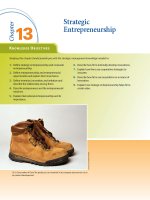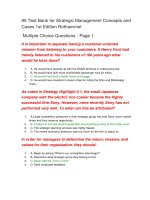Lecture Dalrymple''s sales management: Concepts and cases – Chapter 13: Evaluating performance
Bạn đang xem bản rút gọn của tài liệu. Xem và tải ngay bản đầy đủ của tài liệu tại đây (1.33 MB, 31 trang )
Part V
SALES FORCE LEADERSHIP
Chapter 13:
Evaluating Performance
Why Evaluate Salespeople?
To link compensation and rewards to performance.
To identify salespeople capable of promotion.
To identify training and counseling needs.
To identify criteria for recruitment and selection.
To clarify work expectations.
To motivate salespeople.
To help salespeople set career goals.
A Sales Force Evaluation Model
Set goals and objectives for
sales force, including:
Revenues
Contribution profits
Market share
Expense ratios
Design sales plan
Set product performance standards for:
Organization
Salespeople
Regions
Accounts
Districts
Measure results against
standard
Take Corrective Action
Output Measures Used in Sales Force
Evaluation
Table 13-1 Output Measures Used in Sales Force Evaluation
Sales
Profit
Sales volume dollars
Net profit
Sales volume previous year’s growth
Gross margin percentage
Sales to quota
Return on investment
Sales growth
Net profit as a percentage of sales
Sales volume by product
Gross margin dollars
Sales volume by customer
Margin by product category
New account sales
Accounts
Sales volume in units
Number of new accounts
Sales volume to potential (market share)
Number of accounts lost
Orders
Number of orders
Average order size
Batting average (orders/calls)
Number of accounts sold
Number of accounts buying full line
Output Measures Used in Sales Force
Evaluation
Performance Measure
Sales
Sales volume dollars
Sales volume previous year’s sales
Sales to quota
Sales growth
Sales volume by product
Sales volume by customer
New account sales
Sales volume in units
Sales volume to potential
Accounts
Number of new accounts
Number of accounts lost
Number of accounts buying full line
Percent
Using Performance Measure
79%
76
65
55
48
44
42
35
27
69
33
27
Percent
Using
Profit
Net profit
Gross margin percentage
Return on investment
Net profit asa percentage of sales
Margin by product category
Gross margin dollars
69%
34
33
32
28
25
Orders
Number of orders
Average size of order
47
22
Input or Behavior Bases Used in
Sales Force Evaluation
Table 13-2 Input or Behavior Measures Used in Sales Force Evaluation
Expenses
Effort
Total expenses
Number of calls
Selling expenses to budget
Number of calls per day
Selling expenses as a percentage of sales
Number of calls to quota
Nonselling Activities
Number of days worked
Advertising displays set up
Number of reports turned in
Number of service calls
Number of prospecting phone calls
Number of customer complaints
Selling time vs. non-selling time
Input or Behavior Bases Used in
Sales Force Evaluation
Base
Selling expenses to budget
Total expenses
Selling expenses as a % of sales
Number of calls
Percent
Using
55%
53
49
48
Base
Number of calls per day
Number of reports turned in
Number of days worked
Selling time vs. nonselling time
Percent
Using
42%
38
33
27
Qualitative Bases Used in Sales Force
Evaluation
Table 13-7 Qualitative Bases Used in Sales Force Evaluation
Attitudinal and Personality Factors
Time management
Attitude
Ability to plan
Enthusiasm
Appearance and manner
Cooperation
Knowledge
Creativity and resourcefulness
Product knowledge
Initiative and aggressiveness
Pricing knowledge
Motivation
Knowledge of competition
Selling Skills
Ethical and moral behavior
Communication Skills
Team player
Qualitative Bases Used in Sales Force
Evaluation
Base
Communication skills
Product knowledge
Attitude
Selling skills
Initiative and aggressiveness
Appearance and manner
Knowledge of competition
Team player
Enthusiasm
Percent
Using
88%
85
82
79
76
75
71
67
66
Performance Measure
Time management
Cooperation
Judgment
Motivation
Ethical/Moral behavior
Planning ability
Pricing knowledge
Report preparation and submission
Creativity
Percent
Using
63%
62
62
61
59
58
55
54
54
Sales Data for Bear Computer
1
Company
Volume
Year ($ millions)
2008
2007
2006
2005
26
24
21
17
2
3
Percentage
Industry
Change from Volume
Previous Year ($ millions)
+ 8.3
+14.3
+23.5
300
219
165
125
4
Company
Market Share
(percent)
8.6
10.9
15.7
13.6
Comparing Dollar and Unit Sales at
the Bear Computer Company
Products
Computers
Accessories
----------2007 Sales---------Thousands
Avg Price
of Dollars
Units
Per Unit
----------2008 Sales---------Thousands
Avg Price
Of Dollars
Units
Per Unit
$16,800
4,800
560
4,000
$30,000
1,200
$18,200
5,200
520
4,727
$35,000
1,100
Software
2,400
1,200
2,000
2,600
1,280
2,031
Total
$24,000
5,760
$26,000
6,527
Expense Analysis by Product Line,
Bear Computer Company, 2008
CGS and
Commission
$
CGS as a
Percentage
Of Sales
$18,200
$12,740
70
$5,460
30
Accessories
5,200
3,120
60
2,080
40
Software
2,600
520
20
2,080
80
Total
$26,000
$16,380
Products
Computers
2008 Sales
(000)
63%
Contribution
Margin
$9,620
Contribution
Margin
Percentage
37%
Evaluating Sales Force Performance:
Cost Analysis
What costs are relevant?
Net Sales
Less Variable Costs: Cost of Goods Sold
Sales Commissions
Equals:
Contribution Margin
Less:
Direct Fixed Selling Costs
Equals:
Profit Contribution
Evaluating Sales Force Performance:
Product Costs
CGS + Commissions higher for computers
–
–
–
paying too much for parts
paying too much for parts
competition has driven down selling prices
competition has driven down selling prices
salespeople cutting computer prices to make deals
salespeople cutting computer prices to make deals
possible actions:
possible actions:
limit price negotiation capabilities
limit price negotiation capabilities
shift to a gross margin commission
shift to a gross margin commission
change commission structure to emphasize
change commission structure to emphasize
accessories and software
accessories and software
A Model of Salesperson Evaluation
Input-based System
Output-based System
Behavior
Calls
Reports
Complaints
Demonstrations
Dealer meetings
Display set up
Travel/entertainment
expenses
Results
Sales revenues
Sales growth
Sales/quota
Sales/potential
New accounts
Contribution margins
Contribution
percentage
Salesperson
Evaluation
Measuring Sales Force Output for
Bear Computer Company
Measuring Territory Profit Output for
Bear Computer Company
Territory Performance (thousands)
Jones
Smith
Brown
West
$825
$570
$1,100
$1,000
Less CGS and Commissions
495
428
744
660
Contribution margin
330
142
356
340
40%
25%
32%
34%
55
35
55
65
Travel
15.5
4.1
3.5
5
Food and lodging
12.5
4
3.2
4.5
Entertainment
11.4
0.3
0.5
1
4.5
2.3
2
4.5
$231.10
$96.30
$291.80
$260.00
28%
17%
26%
26%
Net Sales
CM as a percentage of sales
Less direct selling costs
Sales force salaries
Home sales office expense
Profit contribution
PC as a percentage of sales
Ranking Salespeople on 10
Input/Output Factors
Ranking Factors
Ford
Bell
Dollar Sales
1
2
3
4
5
Sales to Potential
5
3
4
2
1
Sales to Quota
5
4
2
1
3
Sales per Order
5
1
4
3
2
Number of Calls
2
5
1
3
4
Orders per call
4
2
5
3
1
Gross Margin Percent
5
1
3
4
2
Direct Selling Costs
4
3
5
1
2
New Accounts
1
4
2
5
3
Number of Reports Turned In
4
3
1
5
2
36
28
30
31
25
Total of Ranks
Shaw
Mann
Gold
Ranking Salespeople on 10
Input/Output Factors
Performance factors
Pete Jones
Ann Smith
Sales (annual)
$1,400,000
$1,100,000
210
225
1,200
1,500
480
750
$19,000
$14,900
5.7
6.7
40%
50%
Sales per order
$2,916
$1,466
Expenses per call
$15.83
$9.93
Expenses per order
$39.58
$19.86
1.35%
1.35%
Days worked
Calls
Orders
Expenses
Calls per day
Batting average (orders per calls)
Expenses as % of sales
Ranking Salespeople on
10 Input/Output Factors
Millions
$
3.87
3.66
3.44
S
A
L
E
S
Y
R
2
3.23
3.02
COMPROMISERS
$3.17
Avg Sales
2.91
Avg contribution
$1.13
Avg contribution
1.09
Avg contribution %
37.4
Avg contribution %
35.8
Age
45
2.80
Calls
2.59
Number of salespeople
2.38
Avg Sales
Avg contribution
Avg contribution %
Age
Calls
Number of salespeople
2.16
1.95
1.74
1.53
1.31
1.10
STARS
Avg Sales
1122
18
Age
37
Calls
888
Number of salespeople
1.78
Avg Sales
Avg contribution
Avg contribution %
Age
Calls
Number of salespeople
0.64
35.8
44
958
11
35.1
2.03
0.75
37.1
35
921
16
SLOWPOKES
LAGGARDS
34.8
11
36.0
36.6
37.2
Contribution Margin (%)
37.8
38.7
Relative Performance Efficiency
for Sales Rep 22
Variable Type
Output
Output
Output
Input
Input
Input
Input
Value
Measured
100
5
45,000
5
20,000
3
60,500
Variable name
Percent Quota Attained (%)
Supervisor Evaluation
Sales Volume ($)
Sales Training
Salary ($)
Management Ratio
Territory Potential ($)
Reference Set
Influence
Salesperson 7
0.49
Salesperson 20
0.43
Salesperson 45
0.08
Value of 100%
Efficient
120
5
50,500
5
18,000
2
50,000
Efficiency=0.85
Iterations=10
Slack
20
0
5,500
0
2,000
1
10,500
Conditions when Outcome versus
Behavioral Systems are preferred
Outcome
Systems(OS)
• Customers need
Customers
information
• Customers trust the
salesperson
• There are ways to
close the deal
• Sales environment
is competitive
Behavioral
System(BS)
• Salespeople lack
experience
• No need to protect
the brand image
• Nonselling
behaviors are a
priority
• Difficult to assign
sales credit
The additional slides below are
not covered in IM
Call Productivity Ratios
Sales to Account =
Dollar Sales
# Accounts
Average Order Size = Dollar Sales
# Orders
Growth Ratio = # New Accounts
Total # Accounts
Account Success =
Accounts Sold
Total # Accounts
Expense Ratios
Expense to Sales
= Expenses
Sales
Cost per Call =
Total Costs
# of Calls









